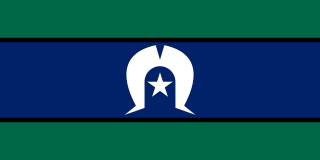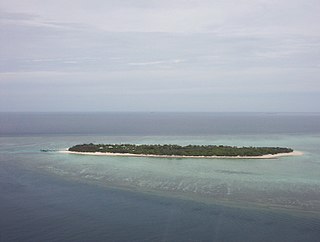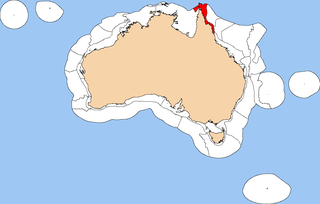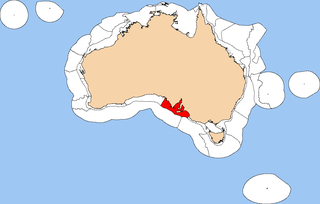
The Great Barrier Reef is the world's largest coral reef system composed of over 2,900 individual reefs and 900 islands stretching for over 2,300 kilometres (1,400 mi) over an area of approximately 344,400 square kilometres (133,000 sq mi). The reef is located in the Coral Sea, off the coast of Queensland, Australia, separated from the coast by a channel 100 miles wide in places and over 200 feet deep. The Great Barrier Reef can be seen from outer space and is the world's biggest single structure made by living organisms. This reef structure is composed of and built by billions of tiny organisms, known as coral polyps. It supports a wide diversity of life and was selected as a World Heritage Site in 1981. CNN labelled it one of the seven natural wonders of the world in 1997. Australian World Heritage places included it in its list in 2007. The Queensland National Trust named it a state icon of Queensland in 2006.

The Torres Strait, also known as Zenadh Kes, is a strait between Australia and the Melanesian island of New Guinea. It is 151 km (94 mi) wide at its narrowest extent. To the south is Cape York Peninsula, the northernmost extremity of the Australian mainland. To the north is the Western Province of Papua New Guinea. It is named after the Spanish navigator Luís Vaz de Torres, who sailed through the strait in 1606.

The Torres Strait Islands are a group of at least 274 small islands in the Torres Strait, a waterway separating far northern continental Australia's Cape York Peninsula and the island of New Guinea. They span an area of 48,000 km2 (19,000 sq mi), but their total land area is 566 km2 (219 sq mi).

A cay, also spelled caye or key, is a small, low-elevation, sandy island on the surface of a coral reef. Cays occur in tropical environments throughout the Pacific, Atlantic, and Indian Oceans, including in the Caribbean and on the Great Barrier Reef and Belize Barrier Reef.

The Northeast Shelf Province is a biogeographic region of Australia's coastal and continental shelf waters. It includes the tropical coastal waters of the central and southern Great Barrier Reef in northeastern Australia. It is a provincial level bioregion in the Integrated Marine and Coastal Regionalisation of Australia (IMCRA) system. It corresponds to the Central and Southern Great Barrier Reef marine ecoregion in the WWF's Marine Ecoregions of the World system.

The Northeast Shelf Transition is a biogeographic region of Australia's coastal and continental shelf waters. It includes the tropical coastal waters of the northern Great Barrier Reef and the Torres Strait in northeastern-most Australia. It is a provincial level bioregion in the Integrated Marine and Coastal Regionalisation of Australia (IMCRA) system. It corresponds to the Torres Strait and Northern Great Barrier Reef marine ecoregion in the WWF's Marine Ecoregions of the World system.

The Southwest Shelf Transition, also known as the Houtman marine ecoregion, is a biogeographic region of Australia's continental shelf and coastal waters. It includes the subtropical coastal waters of Southwest Australia.

The Spencer Gulf Shelf Province, also known as the South Australian Gulfs marine ecoregion, is a biogeographic region of Australia's continental shelf and coastal waters. It includes the warm temperate coastal waters of South Australia's central coast. It is a provincial bioregion in the Integrated Marine and Coastal Regionalisation of Australia (IMCRA) system.
Colin D. Woodroffe is an Australasian geographer and coastal geomorphologist currently serving as professorial fellow at the University of Wollongong. He is the coordinator of the GeoQuEST Research Centre. His international research focuses on the morphology, stratigraphy and sedimentary dynamics of tropical and subtropical coasts, and the application of Geographical Information Systems (GIS) to the study of processes and change in the coastal zone.
In ecology, a priority effect is an impact that a particular species can have on community development due to prior arrival at a site.
Ruth Mason was a New Zealand botanist specialising in the taxonomy and ecology of freshwater plants. She was employed at the Department of Scientific and Industrial Research for 35 years undertaking research into aquatic plants, pioneering new techniques for plant preservation and collecting over 13,000 plant specimens in the field. She was awarded life membership by the New Zealand Ecological Society.

The effect of climate change on small island countries can be extreme because of low-lying coasts, relatively small land masses, and exposure to extreme weather. The effects of climate change, particularly sea level rise and increasingly intense tropical cyclones, threaten the existence of many island countries, island peoples and their cultures, and will alter their ecosystems and natural environments. Several Small Island Developing States (SIDS) are among the most vulnerable nations to climate change.

Eutorna inornata is a moth in the family Depressariidae. It was described by Alfred Philpott in 1927. It is endemic to New Zealand and has been observed in both the North and South Islands. The larvae of this moth are leaf minors of Selliera radicans.

Victoria Metcalf is an Antarctic researcher based in New Zealand, best known for her work on Antarctic fishes and invertebrates. She was awarded the 2006 Zonta Science Award.

The Spermonde Archipelago is a group of around 120 islands off the southwest coast of Sulawesi in Indonesia, located within the Coral Triangle, between the southern arc of Sulawesi and the Strait of Makassar. They comprise two administrative districts within the Pangkajene and Islands Regency of Indonesia's South Sulawesi Province. Situated west of Makassar, the archipelago covers a land area of approximately 141 km2, and comprises around 50 vegetated islands and 70 unvegetated sand cays, of which 43 in total are named. About 50 islands are inhabited, collectively home to 31,293 people at the 2020 Census, and officially estimated at 31,513 as at mid 2021.

Priscilla M. Wehi is a New Zealand ethnobiologist and conservation biologist. As at July 2021 she is an associate professor at the University of Otago and on the first of that month officially undertook the role of director of Te Pūnaha Matatini, a centre of research excellence in complex systems and data analytics. During the COVID-19 pandemic in New Zealand Te Pūnaha Matatini scientists have developed mathematical models of the spread of the virus across the country that influence the New Zealand government's response to the outbreak. In 2021 Wehi was awarded the Hill Tinsley Medal.

Catherine Ellen Lovelock is an Australian marine ecologist, whose research focuses on coastal ecosystems. She is a professor in the School of Biological Science at the University of Queensland and 2020 Georgina Sweet Australian Laureate Fellow.
Tara G McAllister is a New Zealand freshwater ecology academic and is associated with Te Pūnaha Matatini at the University of Auckland. She is a Māori of Te Aitanga ā Māhaki and Ngāti Porou descent.

Patricia M. Fraser is a New Zealand soil scientist at Crown Research Institute Plant & Food Research in Lincoln. Her work focuses on the role of earthworms in the soil, and nitrate leaching, to further understand soil quality in cropping systems. She won a 2020 New Zealand Woman of Influence Award in the Rural category.
Brenda Konar is a marine scientist, and professor at University of Alaska Fairbanks.















